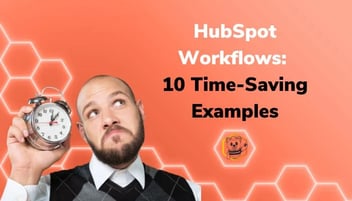
HubSpot Lists 101: When to Use Active vs. Static Lists
Organizing Data with HubSpot lists is a powerful method of managing contacts and companies within your CRM. Keeping all data in one disorganized bucket can be dangerous in an organization. The lists tool is broken down into two sections, active and static. Although both of these methods of creating lists achieve the same results (a segmented list of contacts or companies), it is important to understand the difference in order to master the lists tool. This guide will get you started with the basics on when to use active and static lists.
What is an Active List?
Active lists are created automatically based on properties and filters. Think of this like one of those machines that sorts coins at a bank. The dimes go into the dime slot, the pennies into the penny slot, and so forth. Even though you can dump a massive jar of change into the machine, it will still automatically sort all the coins into their respective slots. The same is true for HubSpot’s active lists. All of the contacts and companies in the CRM are collected into a large, singular list by default, sort of like a contact book or directory. Creating active lists supplements this larger default list by creating groups of contacts or companies based on their respective properties and attributes.
All companies in Chicago, for example, can automatically be added to an active list by setting a location property filter. All contacts with a specific product interest can be similarly added to their own list by setting a filter that relies on a product interest property. Anything that’s tracked in HubSpot through a property can be used as a filter. Filters can also be used together to create even more granular lists. It’s possible to even set up a list that includes every company in Chicago with a specific property interest and activity that’s older than a certain determined period. Organizing data in this way is incredibly useful for observing and quantifying customer information, behavior, and patterns.
What is a Static List?
Static lists are created manually. Think of this like sorting a bowl of chocolates into your favorite flavors, regardless of their contents. Creating an active list involves manually selecting which contacts are added and removed from it. Although this may seem tedious to begin with, it is useful in the long run to have lists like this that can be manually edited. Sometimes, a contact will no longer need to be on a list for reasons that aren’t tracked through a HubSpot property.
Side Note on Lists:
An important distinction between these two types of lists is that their methods of organizing data cannot be used in tandem. You cannot manually add an errant contact to an active list manually, and you cannot use a filter to add or remove contacts from a static list. Because they function separately, they do not overlap in their ability to collect and organize data.
How to Create a List in HubSpot
In your HubSpot portal, navigate to Contacts > Lists. In the upper right, click Create List. In the left panel, select Contact-based to create a list of contacts or Company-based to create a list of companies. In the right panel, enter a name for the list and select if you want an Active list or a Static list.
Here’s a more in-depth HubSpot Knowledge Base article on creating lists.
Ways You Can Streamline Processes Using Active Lists
Manage email subscriptions
When sending automated marketing emails through HubSpot, each email’s recipients are determined by the use of lists. This not only allows for easy communication but also allows for easy determination of who gets which email. For instance, it’s easy to set up a lead nurturing email campaign that only goes out to disengaged or cold leads based on creating a list using their last activity date as the determining filter. On the other hand, you can also use the same filters to send out marketing outreach to hot leads. Any kind of automated email campaign can be set up for distribution to contacts in active lists.
Collect form submissions
A list can be created to compile every user that completes a form on a specific page, a collection of forms on any page, or a form that exists on multiple pages across a website. This gives not only a powerful top-down view of contacts that are created from specific pages, CTAs, and forms but also allows for easy comparison of the efficacy and performance of the respective pages, CTAs, and forms. As always, the more data you collect, the more you can do with it. Active lists have many other applications, ranging from organization to lead management. Lists based on activity dates can filter through active and inactive leads for easy use in determining outreach methods, which can then be implemented through workflows
Ways You Can Streamline Processes Using Static Lists
Manage internal data
A good example is event registrations. If you have a manual record of everyone who is attending an event, you can organize that into a static list in HubSpot. You can also track contacts who still need to complete an offline task or companies who are a high-priority target for unrelated reasons through static lists. Once they complete the task or have been contacted, they can be manually removed from the list just the same.
Keep data in order when filters won’t work
For instance, some specific scenarios require grouping users that may not share similar properties. A great example is an attendance list for a conference. Some users may confirm their attendance through a form, some may confirm their attendance verbally, and some others may just show up to the conference without confirmation. By creating a static list, you can compile users from each of these three groups into a single list and skip the automation process. By compiling this list manually, you then have a complete and holistic record of everyone at the conference that can then be used in lead nurturing campaigns, email drips, and further marketing outreach.
Through HubSpot lists, you can manage your data in effective and dynamic ways. Organization is a crucial aspect of keeping things running smoothly in the HubSpot CRM, and lists are the best way to keep things organized and filtered through day-to-day operations.
For more information about how to create lists, check out the HubSpot Academy course on Segmentation. By using and creating lists, you can better understand your customer data and utilize it to make smart marketing decisions and automate outreach.
Do you have HubSpot for your company, but don't really have the resources to get the most out of it? Is your team overwhelmed with HubSpot tasks? Here's a way to save time and money! Let HIVE Hub be your team of experts — and do it at less than the cost of a single intern! Click on the bear to see what you are missing out on.

|
Why use a HubSpot Partner to help? Workflows can get complex. There are a lot of benefits to using a HubSpot Partner to set up automation processes. Expertise and Experience: HubSpot partners are certified professionals who possess extensive knowledge and experience in using the HubSpot platform. Customization and Personalization: A HubSpot partner can customize workflows to match your unique business requirements. Faster Implementation: HubSpot partners are well-versed in workflow creation and can efficiently implement automation processes. Cost-Effectiveness: While there may be an upfront investment in hiring a HubSpot partner, their expertise can save you valuable time and resources in the long run. By avoiding trial and error, you can ensure that your workflows are well-designed from the start, leading to improved efficiency, better customer experiences, and a higher return on investment. Contact us to learn more about how using a fractional HubSpot admin service like HIVE Hub can benefit your organization. |







![How to Create A HubSpot Call-to-Action [Speed to Lead Ep. 1]](https://blog.gohivehub.com/hs-fs/hubfs/HIVE%20Hub/HubSpot%20Hacks.jpg?width=352&name=HubSpot%20Hacks.jpg)